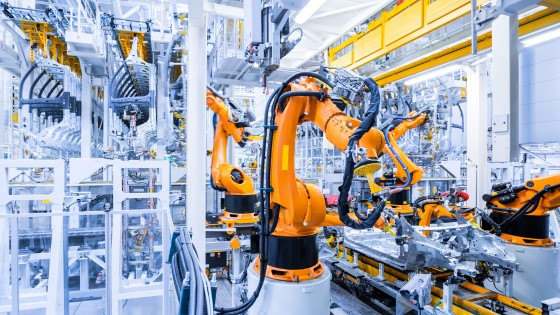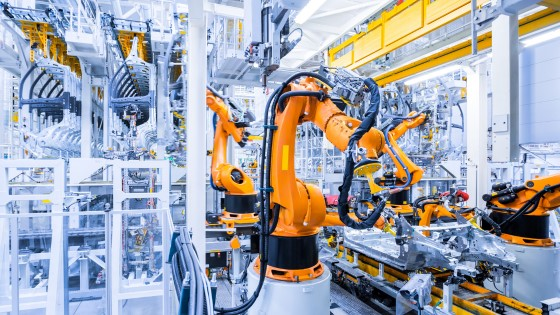
The automotive industry has been a chief driver of process automation and efficiency in manufacturing. After all, it was this industry that made assembly line production a mainstay of modern manufacturing and a key factor behind why it’s a $1.53 trillion industry. Automotive robots are now being used more and more to speed up production.
What Are Automotive Robots? How Are They Used in Car Manufacturing?
It should come as no surprise that automotive robots are exactly what their name dictates; they’re robots who assist in automotive manufacturing processes.
However, how automotive robots are used in car manufacturing is not quite as cut and dry. There are different types of robots that leverage different types of robotics technologies to perform their intended tasks.
For instance, some robots in the automobile industry are autonomous, and others are sophisticated pieces of automated machinery. Some collaborate with other robots, and others need constant human monitoring. Each has different purposes and different technologies.
A breakdown of the different robots used by automakers include:
- Six-axis robots: A six-axis robot is used in car manufacturing to perform tasks such as precise assembly, welding, and material handling. It has six degrees of freedom allowing it to easily maneuver in a three-dimensional space, enabling efficient and accurate construction of car components.
- Collaborative robots: Collaborative robots, often called “cobots,” are used to assist human workers or other robots in tasks such as assembly, material handling, and quality inspection. Traditionally, cobots work alongside humans, enhancing productivity, efficiency, and safety in the automotive manufacturing process.
- Selective Compliance Articulated Robot Arm (SCARA) robots: SCARA is a type of industrial robot known for its rigid structure and horizontal arm design. These can be used in any number of positions in a car manufacturing plant, including the assembly line, warehouse, manufacturing shop, or elsewhere.
- Autonomous Mobile Robots (AMRs): AMRs move about a car plant without human assistance. They are equipped with sensors, onboard computing capabilities, and collision detection to ensure safe movement throughout their location. AMRs help to control labor costs, increase the accuracy of repetitive tasks, and ensure worker safety.
One common thread connecting all car factory robots is this: they make car manufacturing processes faster, easier, and more efficient.
Let’s take a closer look at exactly what these robotic innovations can do.
5 Real World Uses of Robotics in the Automobile Industry
Car Part Painting
Painting processes in car manufacturing plants is a labor-intensive, time-consuming task. Each car part that needs to be painted undergoes numerous treatments and coating applications. This often requires a controlled environment to ensure each piece is uniformly painted without error.
Automotive robots excel at automotive painting tasks. They can apply paint uniformly and precisely, reducing overspray and ensuring a consistent finish. This helps achieve a high-quality appearance while saving time and resources.
Subtractive Manufacturing
Machining metal automotive parts for vehicles involves subtractive manufacturing processes and equipment, such as automated CNC machines. This is material removal facilitated by automated robots and specialized 3D modeling software.
Curious to learn more about the potential of subtractive manufacturing? Visit the Spatial blog:
Welding and Joining Tasks
Welding has long been used by car manufacturers to connect metal pieces of a car together. While joining techniques have expanded to include more cost-effective, environmentally-friendly options, welding and joining are still essential in the automotive manufacturing industry.
Now, robotic welding systems are commonly relied on to join metal components. They can work consistently and quickly to perform high-precision welds, ensuring high-quality and reliable connections. Automotive industry robots are used to automate other joining applications as well.
Assembling
Putting all of a car’s pieces together as quickly and accurately as possible isn’t a new concept to car manufacturers. In 1913, Henry Ford overhauled thea 12-hour assembly time of the Model-T into a mere 93 minutes.
That spirit of automation and innovation in the automotive manufacturing industry still stands today. Robots are being used to automate repetitive and precise assembly tasks in car factories. Car assembly line robots can accurately install parts, apply adhesives, and perform other intricate assembly processes.
Hazardous Materials Handling
Robots play a crucial role in handling various hazardous materials encountered in car manufacturing, such as corrosive chemicals, flammable substances, or potentially harmful byproducts. These robots ensure the safe containment, transportation, and disposal of hazardous materials, minimizing risks to human workers and the environment.
The Advantages of Automotive Robots
With the advent of robotics technology, automotive manufacturers have witnessed a significant transformation in their production processes.
“Robots are revolutionizing the manufacturing industry in a way the industry hasn’t seen in over 100 years. They can drive better efficiency, improve product quality, and minimize workplace safety hazards. Robotics will be a defining part of every manufacturing workflow very soon,” said Shweta Singh, Spatial Head of Product
8 Advantages of Automotive Robots in Car Manufacturing
|
Increased Efficiency |
Robots perform repetitive tasks quickly and accurately, leading to improved production efficiency and reduced cycle times. |
|
Enhanced Quality |
Robots ensure consistent and precise movements, resulting in higher product quality and reliability by minimizing errors and variations. |
|
Improved Safety |
Robots can handle hazardous materials, operate in dangerous environments, and perform physically demanding tasks, reducing the risk of accidents to human workers. |
|
Cost Savings |
Robots reduce labor costs, minimize rework and waste, and optimize material usage, resulting in long-term cost savings for manufacturers. |
|
Flexibility and Adaptability |
Robots can be programmed and reprogrammed to handle different tasks and adapt to changing production requirements, offering flexibility in meeting varied demands. |
|
Increased Production Capacity |
Robots can operate 24/7 without breaks, consistently maintaining high productivity levels and increasing overall production capacity. |
|
Data Collection and Analytics |
Robots equipped with sensors collect real-time data, allowing manufacturers to analyze performance metrics, optimize processes, and make data-driven decisions. |
|
Standardization and Traceability |
Robots adhere to strict quality control standards, ensuring standardized manufacturing processes and facilitating traceability of products. |
What Technology is Behind Automotive Robot Innovations?
Now we know what types of robots are disrupting the automotive manufacturing industry, and why manufacturers are eager to exploit robotic technology. In this section, let’s take a look at how software engineers are making these innovations possible.
Software Development Kits
Behind every robot, regardless of its functionality, is a software program. For many car manufacturing robots, their programs are based on 3D modeling principles and practices that are optimized forto the robot's specific task.
Building a software program specific to each robot from scratch is a labor- and cost-intensive task requiring a specialized skill set. Fortunately, there are 3D modeling software development kits (SDKs) that make customizing software for automotive robots less cumbersome.
Examples of how SDKs make automotive robot software programming more streamlined include:
- Simulation and Visualization. Simulation and visualization features give engineers the ability to see and assess robot movements, reachability, and potential collisions, optimizing the robot's design and programming.
- Path Planning and Optimization: SDKs provide tools for path planning algorithms, allowing engineers to generate optimized robot trajectories. These algorithms consider factors such as obstacle avoidance, energy efficiency, and cycle time reduction, resulting in more efficient and streamlined processes.
- Collaboration and Interoperability. SDKs promote interoperability between different robotic systems and software platforms. They can allow automotive robots to seamlessly interact and collaborate with other automation equipment, control systems, or enterprise software, resulting in a more connected and synchronized manufacturing ecosystem.
Deploy Next-Level Automotive Robots With Spatial’s SDKs
Robotics technology in car manufacturing has brought numerous benefits to the industry, including increased efficiency, enhanced quality, improved safety, and more.
When driving automotive robot innovations, software development kits (SDKs) like Spatial's have played a crucial role, enabling development engineering teams to take advantage of modern robotics potential.
Are you ready to leverage the power of robotics and automation? Automotive robots are just one example of how robotics is changing manufacturing processes. With Spatial's SDKs, you can quickly deploy next-level robots and propel your industry into the future of smart manufacturing.
Contact us today to learn more.

